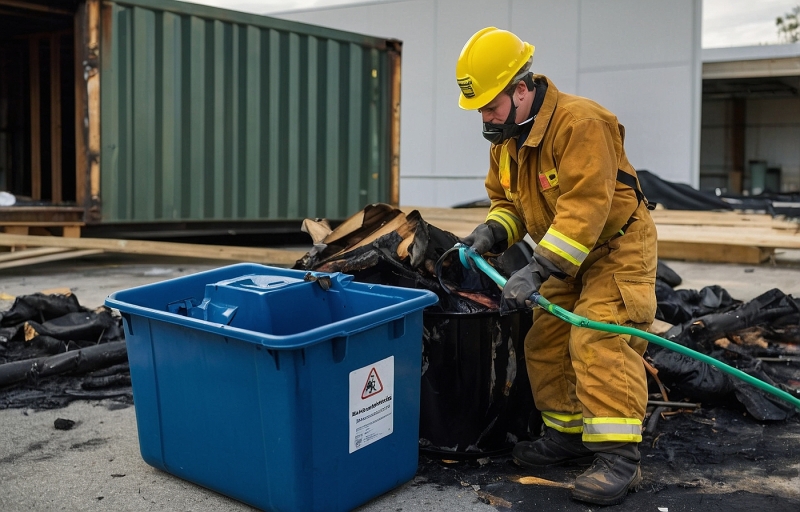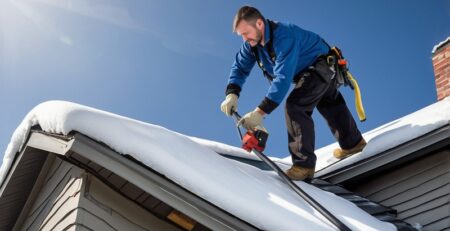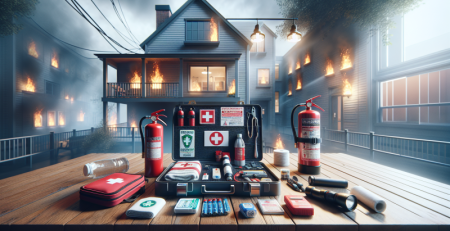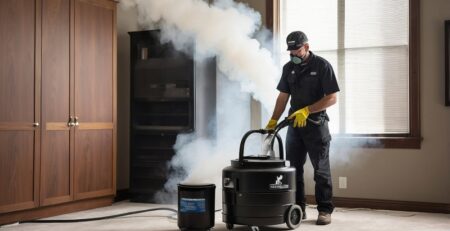Fire Damage: How to Safely Dispose of Burnt Items
Experiencing fire damage in your home or business can be overwhelming, and knowing how to safely dispose of burnt items is a crucial step in the recovery process. Proper fire damage cleanup not only ensures a safer environment but also helps prevent lingering smoke odors and hazardous debris from affecting your property. At Kraus Restoration, we understand the challenges of fire damage restoration and are here to help. As NJ’s leaders in water, mold, and fire damage restoration, our IICRC-certified experts provide 24/7 emergency services with a rapid response to assist homeowners and businesses in Central and Northern NJ. Whether you need guidance on disposing of fire-damaged materials or a full fire damage cleanup, we’re just a call away at (973) 886-2021. Read on to learn the safest and most effective ways to handle burnt items after a fire.
Understanding Fire Damage and Its Impact
Fire damage is a devastating event that can leave lasting consequences on both property and health. When a fire occurs, it not only destroys physical structures but also leaves behind hazardous residues, smoke damage, and weakened materials that can pose serious risks. Understanding the full extent of fire damage is crucial for ensuring proper cleanup and disposal of burnt items. Fire damage is categorized into different levels based on severity, including minor, moderate, and severe destruction. Minor damage may involve smoke stains and superficial burns, while severe damage can result in structural collapse and complete loss of property. According to the National Fire Protection Association (NFPA), U.S. fire departments respond to an estimated 1.35 million fires annually, causing billions of dollars in property damage. The impact of fire extends beyond visible destruction. Smoke and soot can infiltrate walls, furniture, and ventilation systems, leading to long-term air quality issues. Additionally, burnt materials may release toxic chemicals, making it essential to handle disposal with care. The Environmental Protection Agency (EPA) warns that exposure to fire-related pollutants can cause respiratory problems, skin irritation, and other health complications. The psychological toll of fire damage is also significant, as homeowners and business owners often face emotional distress and financial burdens. Proper restoration and cleanup services, such as those provided by fire cleanup experts, are essential for mitigating these effects. Professional restoration teams assess the damage, remove hazardous debris, and restore affected areas to ensure safety. When dealing with fire-damaged items, it is important to determine what can be salvaged and what must be discarded. Items such as charred furniture, melted plastics, and contaminated textiles should be disposed of properly to prevent further hazards. The disposal process should follow local regulations and environmental guidelines to minimize pollution. Seeking assistance from professionals, such as those at restoration services, can help ensure that fire-damaged materials are handled safely and efficiently. Fire damage also affects businesses, disrupting operations and causing financial losses. Commercial properties may require extensive repairs and specialized cleaning to remove smoke odors and restore functionality. Case studies of past fire restoration projects, such as those found in commercial design projects, highlight the importance of professional intervention in restoring fire-damaged spaces. Understanding fire damage and its impact is the first step toward effective recovery. By recognizing the dangers associated with burnt materials and taking appropriate disposal measures, property owners can protect their health and environment. Professional restoration services play a crucial role in ensuring that fire-damaged properties are restored safely and efficiently.
References:
- National Fire Protection Association. “Fire Loss in the United States.” Available at: https://www.nfpa.org/
- Environmental Protection Agency. “Health Effects of Smoke and Soot Exposure.” Available at: https://www.epa.gov/
- Federal Emergency Management Agency. “Fire Damage and Recovery Guidelines.” Available at: https://www.fema.gov/
Assessing the Safety of Burnt Items
After a fire, assessing the safety of burnt items is crucial to prevent health hazards and further property damage. Many materials release toxic fumes and residues when burned, making it essential to determine what can be salvaged and what must be discarded. Begin by inspecting structural components, furniture, and personal belongings for signs of severe charring, warping, or lingering smoke damage. Items made of porous materials, such as upholstered furniture, mattresses, and carpets, often absorb smoke and soot, making them difficult to clean and unsafe for reuse. Additionally, electrical appliances exposed to fire or heat may have compromised wiring, posing a risk of electrical hazards if used again. It is advisable to consult professionals who specialize in fire cleanup to assess the extent of damage and recommend safe disposal methods. Certain materials, such as plastics and treated wood, can release harmful chemicals when burned, requiring careful handling and disposal. If water was used to extinguish the fire, mold growth could become a concern, necessitating expert mold cleanup to prevent further contamination. Proper assessment ensures that only safe and salvageable items remain, reducing potential health risks and facilitating a thorough restoration process. If you are unsure about the safety of specific items, reaching out to a professional team through their contact page can provide expert guidance on the best course of action.
Identifying Hazardous Materials After a Fire
After a fire, identifying hazardous materials is crucial for ensuring safety during the cleanup and disposal process. Fires can produce toxic substances, and many household items may become dangerous when burned. Common hazardous materials include asbestos, lead-based paint, chemicals, and electronic waste. Asbestos, often found in older buildings, can become airborne when disturbed, posing severe health risks. Lead-based paint, when burned, releases toxic fumes and residue that can contaminate surfaces and the air. Household chemicals such as cleaning agents, pesticides, and solvents may react with heat, creating harmful gases or residues. Additionally, electronic devices contain heavy metals like mercury and cadmium, which can be hazardous if not handled properly. Identifying these materials requires careful inspection and, in some cases, professional assessment. If you suspect hazardous materials are present, it is best to seek expert assistance to ensure safe removal. Professional fire damage restoration services can help assess the extent of contamination and recommend appropriate disposal methods. Proper protective gear, including gloves, masks, and goggles, should always be used when handling potentially toxic debris. Additionally, ensuring proper ventilation in the affected area can help reduce exposure to harmful particles. If you need expert guidance on fire damage restoration, consider reaching out to our fire cleanup team for professional assistance. Understanding the risks associated with hazardous materials after a fire is essential for protecting your health and preventing further damage. If you have concerns about contamination or need professional support, do not hesitate to contact our team for expert advice and services.
Proper Disposal Methods for Burnt Furniture
Disposing of burnt furniture after a fire requires careful planning to ensure safety and environmental responsibility. The first step is to assess the extent of the damage. If the furniture is only partially burnt and can be salvaged, consider restoring or repurposing it. However, if the damage is severe, proper disposal is necessary. Start by separating materials such as wood, metal, and upholstery, as different materials require different disposal methods. Wooden furniture that has been heavily charred should be taken to a designated waste disposal facility, as burning it further can release harmful toxins. Metal components can often be recycled, so check with local recycling centers for proper handling. Upholstered furniture, especially if contaminated with smoke and soot, may need to be disposed of as hazardous waste. Contact local waste management services to determine the best disposal options in your area. Some municipalities offer bulk waste pickup services, while others may require you to transport the items to a landfill or recycling center. If you are dealing with a large amount of burnt furniture, hiring a professional cleanup service can be beneficial. Experts in fire cleanup can ensure that all damaged materials are removed safely and in compliance with local regulations. Additionally, consider donating furniture that is still in usable condition to charitable organizations, as some may accept slightly damaged items for refurbishment. Proper disposal not only helps maintain a clean and safe environment but also prevents potential health hazards associated with fire-damaged materials. If you need assistance with fire damage restoration, reach out to professionals who specialize in restoration services to guide you through the process. For further inquiries or to schedule a consultation, you can contact experts who can provide tailored solutions for your specific needs.
How to Handle and Dispose of Burnt Electronics
Handling and disposing of burnt electronics requires careful attention to safety and environmental regulations. When electronic devices are damaged by fire, they can release hazardous substances such as heavy metals, toxic fumes, and corrosive materials. Before disposing of any burnt electronics, it is essential to assess the extent of the damage. If the device is only partially affected, some components may still be salvageable. However, if the electronic item is completely burnt, it must be handled as hazardous waste. Always wear protective gloves and a mask when handling fire-damaged electronics to avoid exposure to harmful substances. It is advisable to disconnect any remaining power sources and ensure that the device is completely cool before attempting to move it. Once the burnt electronics are safely handled, proper disposal methods must be followed. Many local waste management facilities have specific guidelines for disposing of electronic waste, especially when it has been damaged by fire. Contacting a professional fire cleanup service can help ensure that hazardous materials are disposed of safely and in compliance with environmental regulations. Recycling centers that specialize in electronic waste may also accept fire-damaged devices, preventing harmful materials from contaminating landfills. Additionally, some manufacturers offer take-back programs for damaged electronics, providing an eco-friendly disposal option. If you are unsure about the best way to dispose of burnt electronics, consulting with a professional restoration company can provide the necessary guidance. Proper disposal not only protects the environment but also prevents potential health risks associated with toxic substances. For more information on responsible disposal and restoration services, consider reaching out through the contact page.
Dealing with Fire-Damaged Clothing and Fabrics
Fire-damaged clothing and fabrics require careful handling to determine whether they can be salvaged or need to be discarded. The extent of the damage, the type of fabric, and the presence of smoke, soot, or chemical residues all play a role in deciding the best course of action. Some fabrics, especially synthetic ones, may melt or become structurally weak when exposed to high temperatures, making them unsafe for reuse. Natural fibers like cotton and wool may absorb smoke odors and soot, requiring specialized cleaning techniques. Before attempting to clean fire-damaged clothing, inspect each item thoroughly. If the fabric has visible charring, extensive burns, or a strong chemical odor, it is best to dispose of it properly. Items that are only mildly affected by smoke or soot may be restored using professional cleaning methods. Dry cleaning or specialized laundering techniques can help remove stubborn odors and stains. However, washing fire-damaged clothing at home may not always be effective, as regular detergents may not break down the soot and smoke particles embedded in the fabric. In such cases, seeking professional assistance from a fire cleanup service can ensure that the clothing is treated with the appropriate cleaning agents and techniques. Additionally, fire-damaged fabrics may also pose health risks due to lingering toxins and irritants. Prolonged exposure to smoke-damaged clothing can cause skin irritation or respiratory issues, especially for individuals with allergies or sensitivities. If there is uncertainty about the safety of an item, it is advisable to err on the side of caution and dispose of it. Proper disposal of fire-damaged clothing involves placing them in sealed bags to prevent the spread of soot and contaminants. Local waste management guidelines should be followed to ensure safe disposal. In cases where fire damage has affected a significant portion of a home, consulting a professional restoration service can help assess the extent of the damage and recommend the best approach for handling affected materials. Additionally, if water was used to extinguish the fire, there is a risk of mold growth in damp fabrics. In such situations, seeking assistance from a mold cleanup expert can help prevent further damage and health hazards. Taking the right steps in dealing with fire-damaged clothing and fabrics ensures a safer environment and minimizes potential risks associated with lingering fire residues.
Safe Disposal of Burnt Paper and Documents
Properly disposing of burnt paper and documents is crucial to prevent environmental hazards and ensure sensitive information remains secure. After a fire, assess the extent of the damage and separate partially burnt documents from completely charred ones. If the papers contain personal or confidential information, consider shredding them before disposal to prevent identity theft. Ash and small burnt fragments should be collected carefully using protective gloves and placed in a fire-resistant bag or container. Avoid scattering the ashes in open areas, as they can become airborne and cause respiratory issues. Instead, dispose of them in a designated waste disposal site or consult local waste management services for proper guidelines. Recycling may be an option for papers that are only slightly damaged, but confirm with local recycling centers if they accept fire-damaged materials. If the fire resulted in extensive damage, professional cleanup services might be necessary to handle the debris safely. You can explore specialized fire cleanup solutions to ensure thorough and safe disposal. Additionally, if water was used to extinguish the fire, there may be risks of mold growth on damp documents. In such cases, seeking expert mold cleanup assistance can help prevent further damage. For personalized guidance on handling fire-damaged materials, consider reaching out through the contact page to consult with professionals.
Managing Smoke-Damaged Items Effectively
Smoke-damaged items require careful handling to prevent further contamination and ensure a safe living environment. The first step in managing these items is to assess the extent of the damage. Some materials, such as porous fabrics, upholstery, and paper products, tend to absorb smoke particles deeply, making them difficult to restore. Non-porous items like glass, metal, and certain plastics may be easier to clean and salvage. It is essential to separate salvageable items from those that need disposal to streamline the cleaning process. Professional cleaning techniques, such as ozone treatment and thermal fogging, can help eliminate stubborn smoke odors from furniture, clothing, and household items. Additionally, using specialized cleaning solutions designed for smoke damage can improve the chances of restoring affected belongings. If you are unsure about the best approach, consulting a professional fire cleanup service can provide expert guidance and ensure proper restoration. Items that cannot be effectively cleaned should be disposed of safely to prevent lingering odors and potential health risks. Proper ventilation and air purification are also crucial in reducing smoke residue in the home. HEPA air filters and activated carbon filters can help remove airborne particles and improve indoor air quality. If structural elements of your home have been affected, it may be necessary to seek assistance from a professional residential design expert to assess and restore damaged areas. Taking swift action to clean and restore smoke-damaged items can help minimize long-term effects and ensure a safe and healthy living space. If you need further assistance, do not hesitate to contact a restoration specialist for professional support.
Recycling Options for Fire-Damaged Materials
Recycling fire-damaged materials is an essential step in minimizing waste and promoting environmental sustainability. While some burnt items may be beyond salvage, many materials can be repurposed or recycled through specialized processes. Metals such as aluminum, steel, and copper often retain their properties even after exposure to high temperatures, making them ideal candidates for recycling. These materials can be taken to a local scrap yard or recycling center, where they are melted down and reused in new products. Similarly, certain types of glass, particularly tempered glass, may be recyclable if they have not been excessively damaged. Wood from fire-damaged structures can sometimes be repurposed for mulch or biofuel, provided it is free from hazardous chemicals. Concrete and bricks, if structurally sound, can be crushed and used as aggregate in new construction projects. Paper and cardboard that have only been partially damaged may also be recyclable, though they must be dry and free from soot or chemical contamination. For homeowners and businesses dealing with fire damage, working with professionals who specialize in fire cleanup can help determine which materials can be salvaged and properly recycled. Additionally, consulting with local waste management authorities ensures compliance with environmental regulations and helps identify the best recycling options available. If you are unsure about how to handle fire-damaged materials, reaching out to experts through contact services can provide valuable guidance. By taking the time to recycle what is possible, individuals can contribute to reducing landfill waste and supporting sustainable rebuilding efforts. For those looking to restore their property after a fire, exploring professional services can streamline the recovery process and ensure safe disposal of hazardous materials.
When to Call Professional Disposal Services
In the aftermath of a fire, determining whether to handle the disposal of burnt items yourself or seek professional assistance is crucial for safety and efficiency. While minor fire damage may allow for personal cleanup, extensive destruction often requires the expertise of professional disposal services. If the fire has affected structural components, released hazardous materials, or left behind toxic residues, it is best to call experts who specialize in fire damage cleanup. Professionals have the necessary equipment and knowledge to safely remove and dispose of charred debris, ensuring compliance with local regulations. Additionally, certain materials, such as electronics, appliances, and chemically treated wood, require specialized handling to prevent environmental contamination. If you are unsure about the extent of the damage or the proper disposal methods, consulting a professional service can prevent health risks and further property damage. Companies that offer fire cleanup services can assess the situation and provide a comprehensive plan for safe disposal. Furthermore, if the fire has resulted in water damage from firefighting efforts, professionals can also assist with water cleanup to prevent mold growth and structural deterioration. Seeking expert help not only ensures a thorough cleanup but also provides peace of mind, knowing that your property is being restored safely and efficiently. If you need assistance with fire damage disposal or restoration, do not hesitate to contact a trusted service provider to handle the process professionally.
Legal and Environmental Considerations for Disposal
Proper disposal of fire-damaged items requires careful attention to both legal regulations and environmental concerns. Many materials affected by fire, such as charred wood, melted plastics, and hazardous chemicals, must be handled according to local waste management laws to prevent contamination and health risks. It is essential to check with local authorities or waste disposal services to determine the correct procedures for disposing of specific materials. Some items, such as electronics and appliances, may contain hazardous substances that require specialized disposal methods to prevent environmental harm. Additionally, burned materials can release toxic fumes and residues, making it crucial to follow safety guidelines when handling and transporting them. Recycling and repurposing certain materials, when possible, can help reduce waste and minimize environmental impact. Professional restoration services can assist in the safe removal and disposal of fire-damaged items, ensuring compliance with legal requirements. If you need expert assistance, consider exploring our fire cleanup solutions. Understanding the environmental impact of improper disposal is also vital, as burned materials can contribute to soil and water contamination if not handled correctly. Responsible disposal practices help protect the ecosystem and community health. For more information on how we can assist with restoration and cleanup, visit our about page or check out our latest projects.
Preventing Health Risks from Fire-Damaged Items
Fire-damaged items can pose serious health risks if not handled and disposed of properly. The aftermath of a fire often leaves behind toxic residues, soot, and hazardous materials that can be harmful to both humans and the environment. Exposure to these contaminants can lead to respiratory issues, skin irritation, and other long-term health complications. To minimize these risks, it is crucial to assess the extent of the damage and determine which items can be salvaged and which need to be discarded. Porous materials such as carpets, upholstered furniture, and mattresses tend to absorb smoke and toxins, making them difficult to clean effectively. These items should be carefully removed and disposed of according to local regulations. Non-porous materials like metal and glass may be salvageable with thorough cleaning, but it is essential to use protective gear such as gloves and masks when handling them. Additionally, fire-damaged electronics and appliances should be discarded as they may contain internal damage that could lead to electrical hazards. Proper ventilation is also necessary when dealing with fire-damaged areas to prevent inhalation of harmful particles. Professional restoration services can help assess the damage and provide guidance on safe disposal methods. Seeking expert assistance from a trusted company like fire cleanup specialists ensures that hazardous materials are handled correctly, reducing the risk of exposure. Mold growth is another concern after a fire, especially in areas affected by water used to extinguish the flames. Addressing this issue promptly with mold cleanup services can prevent further health complications. Proper disposal of fire-damaged items also involves following local waste management guidelines to ensure that hazardous materials do not contaminate the environment. If you are unsure about the correct disposal methods, reaching out to professionals through the contact page can provide you with the necessary information and assistance.
Cleaning Up After Fire Damage: Best Practices
Cleaning up after fire damage requires a strategic approach to ensure safety and efficiency. The first step is assessing the extent of the damage and identifying which items can be salvaged and which need to be discarded. It is crucial to wear protective gear such as gloves, masks, and goggles to avoid exposure to hazardous materials like soot, ash, and toxic fumes. Proper ventilation is also essential to reduce lingering smoke odors and airborne contaminants. When disposing of burnt items, follow local regulations to ensure hazardous waste is handled correctly. Non-salvageable materials, including charred furniture, damaged insulation, and burnt electronics, should be carefully removed and placed in designated disposal areas. Cleaning surfaces affected by smoke and soot requires specialized techniques, such as using dry sponges for walls and ceilings and applying appropriate cleaning solutions for different materials. Professional restoration services can help restore the property efficiently and prevent further damage. If water was used to extinguish the fire, addressing moisture buildup is critical to prevent mold growth. Consider seeking expert assistance for water cleanup to mitigate potential risks. Additionally, fire damage can weaken structural components, making it necessary to inspect walls, floors, and ceilings for stability. Engaging professionals for fire cleanup ensures thorough restoration and safety compliance. Once the cleanup process is complete, deodorizing the space and improving air quality with air purifiers and ventilation systems can help eliminate persistent smoke odors. For personalized guidance and expert assistance, reach out through the contact page to discuss your specific restoration needs.
Restoring Your Space After Fire Debris Removal
Restoring your space after fire debris removal is a crucial step in reclaiming your home or business. Once the burnt items and hazardous materials have been safely disposed of, the focus shifts to cleaning, repairing, and revitalizing the affected areas. The first step in this process is deep cleaning to eliminate soot, smoke residue, and lingering odors. Specialized cleaning techniques, including air purification and surface scrubbing, help restore indoor air quality and prevent further damage. Walls, ceilings, and floors may require repainting or refinishing to remove stains and discoloration caused by smoke exposure. Additionally, structural repairs may be necessary to address weakened or damaged areas. Professional restoration services can assess the extent of the damage and recommend the best course of action to ensure a safe and thorough recovery. Replacing insulation, repairing electrical systems, and restoring plumbing are essential tasks to make the space habitable again. If water was used to extinguish the fire, addressing moisture issues is critical to prevent mold growth. Engaging experts in water cleanup can help mitigate potential risks and ensure a dry, safe environment. Beyond structural repairs, restoring personal belongings and furniture is another important aspect of recovery. Salvageable items should be professionally cleaned and deodorized, while irreparable items should be replaced. A well-planned restoration process also includes redesigning the space to enhance functionality and aesthetics. Whether it is a home or a commercial property, working with professionals experienced in commercial design can help bring new life to the space. Additionally, seeking expert guidance in fire cleanup ensures that all safety protocols are followed, reducing the risk of future hazards. Restoring your space after fire damage requires patience, expertise, and a strategic approach to ensure a successful recovery.
FAQ: Fire Damage – How to Safely Dispose of Burnt Items
Dealing with fire damage can be overwhelming, and knowing how to properly dispose of burnt items is crucial for safety and environmental responsibility. Below are some frequently asked questions to help guide you through the process.
1. Why is it important to dispose of burnt items properly?
Proper disposal of fire-damaged items is essential to prevent health hazards, environmental contamination, and further property damage. Some materials release toxic fumes or chemicals when burned, making safe handling and disposal critical.
2. What items should be discarded after a fire?
You should dispose of:
- Charred or structurally compromised furniture that cannot be restored.
- Burnt clothing and textiles that have absorbed smoke and chemicals.
- Food and beverages exposed to heat, smoke, or firefighting chemicals.
- Electronics and appliances that have suffered heat or water damage.
- Melted plastics that may release harmful toxins.
3. Can I throw burnt items in my regular trash bin?
It depends on local regulations. Some fire-damaged items, especially hazardous materials, require special disposal methods. Check with your local waste management services for guidelines on disposing of fire-damaged debris.
4. How should I handle hazardous materials after a fire?
Hazardous materials such as chemicals, batteries, and asbestos-containing materials should be handled with extreme caution. Contact your local hazardous waste disposal facility for proper disposal instructions.
5. Can burnt furniture or wood be recycled?
Lightly damaged wooden furniture may be salvageable, but heavily burnt wood should not be used or recycled due to potential structural weakness and contamination. Some wood may be accepted at specialized recycling centers, but check with local facilities first.
6. What should I do with fire-damaged electronics?
Electronics exposed to fire, smoke, or water may be unsafe to use. Do not attempt to power them on. Instead, take them to an e-waste recycling center or a hazardous waste disposal facility.
7. How do I dispose of burnt clothing and textiles?
If clothing is only smoke-damaged, it may be salvageable with professional cleaning. However, if it has been burned or exposed to toxic chemicals, it should be discarded in accordance with local waste disposal guidelines.
8. Can I donate items that survived the fire?
If items are free from smoke damage, chemicals, and structural issues, they may be suitable for donation. However, always check with donation centers, as they may have specific guidelines on accepting fire-damaged goods.
9. How do I safely clean up and dispose of ash and soot?
Wear protective gear such as gloves and masks when handling ash and soot. Use a vacuum with a HEPA filter or damp cloths to clean surfaces. Dispose of ash in sealed bags to prevent it from becoming airborne.
10. Who can help with fire damage cleanup and disposal?
Professional fire damage restoration services can assist with cleanup, salvageable item assessment, and proper disposal of hazardous materials. Additionally, local waste management and environmental agencies can provide guidance on disposal regulations.
If you’re dealing with fire damage, always prioritize safety and follow local disposal guidelines to protect yourself and the environment.










